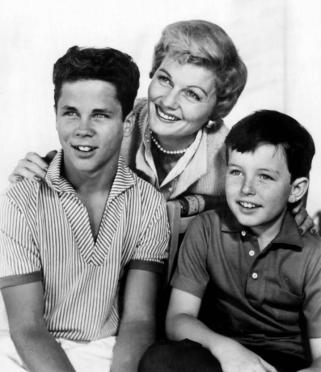
Photo Credit: Photo of Barbara Billingsley (June Cleaver) with Tony Dow (Wally Cleaver) and Jerry Mathers (Theodore “Beaver” Cleaver) from the television series Leave It to Beaver, 9 July 1959, ABC Television: We hope/Wikimedis Commons/PD US no notice
In light of my book, Lessons From My Mother’s Life, that came out last week, I wanted to revisit one of the most iconic TV characters of the 1950s.
It recently came to my attention that, while the name June Cleaver conjures up very specific images in the minds of many Americans (of an older generation, especially), not everyone knows who June is. June was the mom on the family television show that aired between 1957 and 1963 called Leave It to Beaver. The show was about a typical American suburban family of the 1950s and encompassed all of the stereotypes we associate with the post-war nuclear family: a father who has a good job and is the undisputed “head of the family,” a mother who epitomizes the feminine mystique, and two smart, good-natured kids (in this case, two boys, the younger of which is nicknamed Beaver and forms the central character of the series). The show was a huge hit in the Occupation: Housewife era because it offered Americans who were recovering from the horrors of World War II exactly the kind of life they wanted — stable, family-oriented, and prosperous.
June Cleaver was exactly the kind of woman Betty Friedan would have considered the poster child for the feminine mystique (interestingly, Friedan never mentions June, though that may be because the show was still running at the time of the book’s publication). Her role in life is that of a housewife and mother and she has no desire do be anything beyond that. Her life revolves around her husband, two sons and her house, which is always immaculate and polished. She even presents the kind of 1950s housewife in the advertisements, complete with high heels and pearls, which she wears even when she’s doing housework.
But, just as with many television and film characters, there is more to June than meets the eye. One of the most interesting scenes of Beaver finds June arguing against the rather myopic opinions of her young son, Beaver, about women and intelligence. The scene is fascinating because Beaver, probably about eleven or twelve here, brings forth some of the views in the 1950s that Friedan outlines in her book, The Feminine Mystique: that intelligence for women wasn’t an issue because they only had to get married and have families, and if they did work, they had “jobs” (and highly feminized ones at that) and not “careers.” June counters this by reminding Beaver that, nowadays, women can have careers and their intelligence is as good as any man’s. It’s significant that the episode aired in 1960, when women were beginning to wake up to the fact that the post-war image of the feminine mystique might not be serving them well as individuals.

Photo Credit: Photo of Barbara Billingsley and Hugh Beaumont as June and Ward Cleaver from the television series Leave it to Beaver, 15 September 1958, ABC Television: Crakkerjakk/Wikimedia Commons/PD US no notice
June also was a match for her husband, Ward. If June was the poster child for the 1950s woman, Ward epitomized a lot of what American men were expected to be after World War II: ambitious, strong-willed, and forceful. He’s in no way a bully but let’s just say, we know where The Beaver got his opinion of women in the previously mentioned episode, as this clip tells us. Although June defers to Ward in most important decisions in the show, she doesn’t do so meekly. She has her own opinions and voices them.
And just a word about June’s pearls and high heels. These things were part of what made June Cleaver an icon and also won the character a lot of criticism from the second wave feminist movement, because, they reasoned, women were not dolls to be on display all the time. But, as Barbara Billingsly, the actress who played June, points out here, there were actually very practical reasons for both the pearls and heels. She wore the necklace to hide a hollow in her neck that was causing an unseemly shadow on film, and the high heels were because, throughout the six years Beaver aired, both actor Jerry Mathers (who played The Beaver) and Tony Dow (who played older brother Wally) grew, as boys do, and both became quite tall. So she had to wear the heels to keep up with their growth spurts!
You can check out more about how women lived in post-World War II America in my new book, Lessons From My Mother’s Life, here.

